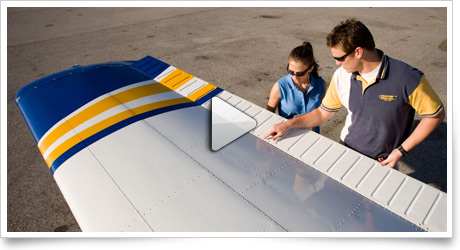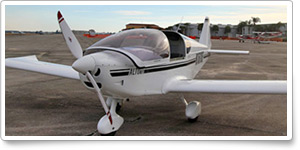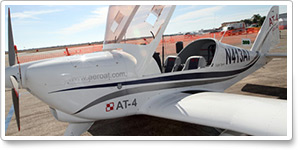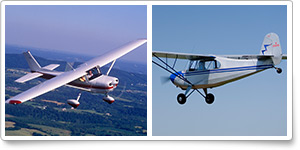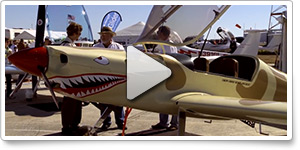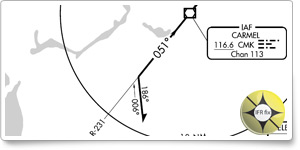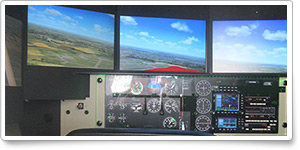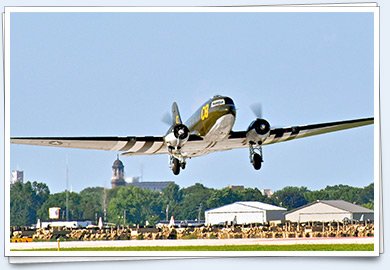| ||||||
| Fuller unveils effort to boost training |
| |||||
| Click here for this week's custom content. | ||||||
FeaturedFuller unveils effort to boost flight training excellence | |
GA NewsSebring LSA expo booms with traffic, salesGood weather, good attendance, and strong sales gave light sport aircraft manufacturers a lift at the Sebring U.S. Sport Aviation Expo Jan. 19 through 22. The eighth annual show in Sebring, Fla., set records for traffic and attendance, according to organizers still working on the final tallies. FAA officials logged 1,256 air operations Jan. 21, the busiest day of the show, including 200 in the first hour—a rate of arrivals and departures that rivaled the nation's busiest airports, and made Sebring Regional Airport the busiest airport in Florida. Read more and view a slideshow >> Controlling show traffic 'an adrenaline rush'FAA Operations Manager Boyd Martin said working the air traffic control tower at the Sebring U.S. Sport Aviation Expo is a thrill. Martin, part of a staff of 21 FAA technicians, controllers, and managers deployed for the Jan. 19 through 22 event, said serving the busiest airspace in Florida is for controllers "an adrenaline rush," similar to what skydivers or bungee jumpers feel when they take the plunge. Read more >> Air-conditioned Alto stands out at low speeds LSA financing options abound for individualsFor well-qualified individual buyers, financing a light sport aircraft purchase is no different from financing a certified aircraft, provided the aircraft in question is one of the top-selling and established brands. That according to Bank of America Senior Vice President, Aircraft Financing Jennifer Giampietro, who said the 60-percent approval rate on loan applications for LSA purchases is virtually identical to the approval rate for all aircraft loans (62 percent). AOPA has teamed up with Bank of America for more than 15 years to offer members easy access to financing. Read more >> Gobosh reborn as Aero AT-4 Deaf pilot spreads the word: You can flyGreg Lawrence's aviation career, logging 3,000 hours over the course of nearly a half century, would be relatively unremarkable by general aviation standards, but for one thing. "I'm deaf," explained Lawrence, 63, whose hearing loss dates to an early childhood illness. Taught to speak by his grandmother, Lawrence retains partial hearing—enough to understand air traffic controllers more often than not. Read more >> Dogfight: The perfect trainer Cessna shows positive revenue in fourth quarterCessna finally turned a long-awaited corner in the current economic downturn, but has firmly identified itself as a small- and medium-sized jet manufacturer for the future. Piston-engine aircraft not only survived in the fourth quarter of 2011, but helped lead the way to higher revenues. Read more >> EAA to expand Young Eagles programFor too many would-be pilots, the path to that first certificate diverts to a dead end. Eagle Flights, a new initiative outlined for light sport aircraft industry leaders by EAA President Rod Hightower on Jan. 19, is designed to address a critical shortcoming of pilot training: As many as eight in 10 pilots who start training never earn a certificate. Eagle Flights is essentially an expansion of the long-running Young Eagles program that has given 1.6 million youngsters their first aviation experience. Read more >> Tecnam launches 50-state demo, discount programTecnam North America CEO Phil Solomon on Jan. 19 took the first $500 deposit on a discounted light sport aircraft, with up to 499 more aircraft available at 20 percent off the base price. Read more >> FAA issues Super Bowl TFRWith the matchup for Super Bowl XLVI now set, aviators are beginning to make final plans and preparations for the Feb. 5 game in Indianapolis. More than 1,000 general aviation aircraft are expected to converge on the region, with airports up to 70 miles from Lucas Oil Stadium preparing to handle an estimated 3,500 air operations during the week of the game. The FAA issued a notam Jan. 23, establishing a 30-nautical-mile-radius temporary flight restriction around the stadium for the game; the Super Bowl Host Committee has updated its website with new information for pilots, including the previously released notam detailing temporary Class D airspace to be established at three nearby airports. | ||||||||||||||||||||||||||||||||||||||||||||
Flight Instructor Refresher Clinics | Air Safety Institute Safety Seminars | |||||||||
For a complete schedule, see AOPA Online. Can’t make it in person? Sign up for the CFI Refresher Online. |
Topics vary—for details and a complete schedule, see AOPA Online. | |||||||||
ADVOCACY
FAA reauthorization bill on the move
Despite 23 short-term FAA reauthorization bills and a brief partial shutdown last summer, House and Senate Transportation members from both parties expressed new optimism that the way has finally been cleared for a long-term authorization package for the agency. Read more >>
Pilot's Bill of Rights introduced in House
Reps. Sam Graves (R-Mo.) and Daniel Lipinski (D-Ill.) have introduced a "Pilot's Bill of Rights" measure to give aviators more protection and access to information during FAA enforcement actions. They are urging their colleagues in a letter to co-sponsor its proposed reforms. A similar bill introduced in 2011 by Sen. James Inhofe (R-Okla.) is pending in the Senate. Read more >>
FAA issues notice of policy on new airborne wind energy systems
The FAA is asking for public participation as it integrates an emerging technology known as airborne wind energy systems (AWES) into the National Airspace System. The agency will accept public comments until Feb. 6 on AWES, which it describes in a notice of policy published Dec. 7 as “mechanical devices that are moored to the ground, via a tether, for the purpose of capturing the fluid stream kinetic energy of winds.” Read more >>
Odds are good to quash user fees in 2012, Fuller says
 The first question AOPA President Craig Fuller fielded from the audience of about 150 attending his pilot town hall Jan. 20 in Sebring, Fla., was about user fees. What are the chances of stopping the latest push, an attendee wanted to know. The odds are good, Fuller said—this year, at least. AOPA is working, as it has successfully many times before, to mobilize congressional opposition to a burden on GA that could compromise safety by discouraging pilots from utilizing flight following and other air traffic services. Read more >>
The first question AOPA President Craig Fuller fielded from the audience of about 150 attending his pilot town hall Jan. 20 in Sebring, Fla., was about user fees. What are the chances of stopping the latest push, an attendee wanted to know. The odds are good, Fuller said—this year, at least. AOPA is working, as it has successfully many times before, to mobilize congressional opposition to a burden on GA that could compromise safety by discouraging pilots from utilizing flight following and other air traffic services. Read more >>
Nebraska airport zoning measure nears vote
AOPA is urging members of the Nebraska state Senate to back a pending bill that would enhance aviation safety and promote commonsense land development around airports. LB 352, sponsored by Sen. Scott Lautenbaugh last January, would achieve those goals by defining and providing dimensions of airport hazard areas, including extending approach zones from the current three miles to 10 miles from any IFR runway. Read more >>
Member Benefits
AOPA gets member his medical back in ten minutes
When prostate cancer grounded Jim Anderson, the impact was great. He is an aerial photographer, so not only did he lose his privilege to fly, but he also lost the way he earns his living. Once his tests were clean and it was time to get his medical back, he contacted AOPA as a member of the Medical Services Plan. Read more >>
New, improved AD&D insurance plan offers 24/7 coverage
AOPA members who enroll in the AOPA Accidental Death and Dismemberment insurance plan will now benefit from new expanded offerings and 24/7 coverage, all available at no additional cost. A favorite among pilots looking for coverage while flying, the AOPA Accidental Death and Dismemberment insurance plan has undergone some exciting changes, making it more beneficial than ever before for members to enroll. Read more >>
Fly Well: Is it a bird? Is it a plane?
Who didn't love Superman and his alter ego, Clark Kent? Mere humans can't attain X-ray vision like the superhero, but they may be able to correct vision problems with laser refractive surgery. Dr. Jonathan Sackier discusses the procedure and what it might mean for your medical certificate. Read more >>
AOPA Career Opportunities
Ever dream of turning your passion for aviation into a career? We’re looking for a chief flight instructor, manager of flight training programs, AOPA Live producer/videojournalist, and associate editor–Web/ ePilot. To learn more about other AOPA career opportunities, visit AOPA Online.
Community
Picture PerfectAOPA’s online photo gallery allows you to upload your own aviation photography as well as view, rate, and comment on others’ photos. Your favorite aviation images from AOPA Pilot are still available online through this new gallery. Take a look, and submit your own photos! | | |
Rally GACheck out user-submitted events from your region. To include an event or to search all events in the calendar, visit AOPA Online. AOPA does not endorse the events listed below, nor have ePilot editors edited the submissions. AOPA assumes no responsibility for events listed.
| |
| |
QUIZ ME!Here’s a question asked by an AOPA member who contacted our aviation services staff through the AOPA Pilot Information Center. Test your knowledge.
Question: I hold a flight instructor certificate, and own an experimental light sport aircraft that I built. I would like to teach my daughter how to fly in this aircraft, but am unclear as to what restrictions, if any, I'm facing because of the airplane's experimental airworthiness certificate. Is it legal to provide flight instruction in this airplane?
Answer: Yes, in this situation your daughter can receive flight training in an experimental light sport aircraft (E-LSA). Restrictions that apply to any aircraft issued an experimental airworthiness certificate are published in FAR 91.319. This regulation does not prohibit you from giving flight instruction in the aircraft; however, you cannot rent or charge for the use of the airplane itself—which FAR 91.319 does prohibit. In this case, you would not be renting the aircraft to your daughter, so it would be allowed.
In addition, the airplane must have already completed its flight testing phase (phase one operations). During phase one operations, only the pilot can be in the aircraft, so no dual flight instruction could take place in the aircraft during this time. Assuming that the aircraft has completed phase one operations and has been moved into phase two (normal) operations, flight training in the aircraft would be allowed.
Consideration must be given to your insurance coverage as well. AOPA recommends confirming that your daughter would be covered for her solo operations in the aircraft as a student pilot. Browse the Experimental Aircraft Association's information on experimental aircraft online.
Got a question for our aviation services staff? The AOPA Pilot Information Center is a service available to all members as part of the annual dues. Call 800/USA-AOPA (800/872-2672), or email to [email protected]. |
| |
|
|
| |
| | ||||
| ePilot Editor: Sarah Brown | Contributors: Alyssa Miller Jim Moore Jill W. Tallman Warren Morningstar Alton K. Marsh | | Production Team: Melissa Whitehouse Siobhan Byrne Lezlie Ramsey Mitch Mitchell William Rockenbaugh | Advertise in ePilot: |
| Member Tools: Send feedback | ePilot Archive © 2012 Aircraft Owners and Pilots Association | 421 Aviation Way Frederick, MD 21701 | Phone 800/USA-AOPA | Fax 301/695-2375 | ||||




